Iris NightPilot, Humminbird SmartStrike, Vesper AIS update, and Icom 7300 HF Radio
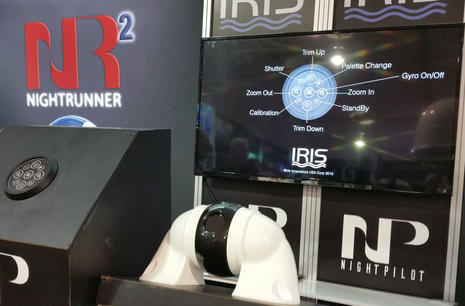 Stormtroopers will be pleased with a new value-priced gyro stabilized thermal camera from Iris Corporation. The Iris255 NightPilot looks like an accessory from Star Wars and includes some pretty hi-tech wizardry considering its $4,895 suggested retail price. Specs include 320 x 240 resolution, 8x digital zoom, and built-in heater with automatic temperature control for cold conditions. And since Panbo wondered if the Iris NightRunner PTZ cam “was too good to be true” in 2013, the company seems to have established itself as a serious player in lower priced thermal cameras…
Stormtroopers will be pleased with a new value-priced gyro stabilized thermal camera from Iris Corporation. The Iris255 NightPilot looks like an accessory from Star Wars and includes some pretty hi-tech wizardry considering its $4,895 suggested retail price. Specs include 320 x 240 resolution, 8x digital zoom, and built-in heater with automatic temperature control for cold conditions. And since Panbo wondered if the Iris NightRunner PTZ cam “was too good to be true” in 2013, the company seems to have established itself as a serious player in lower priced thermal cameras…
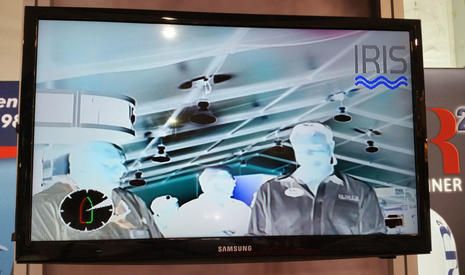 This photo shows similar Iris thermal imagery when the NightPilot was introduced at the Fort Lauderdale boat show. Note that the camera was in white/hot mode (Ben thinks) and perhaps sharp readers can explain why the seemingly hot ceiling lights show as cold dark black? The NightPilot is intended to be mounted in a fixed position, presumably looking dead ahead, and will only tilt — no pan. Trim is manually adjustable to compensate for installation angle. The camera’s gyro controlled motor moves at a purported rate of 360 degrees per second compensating 70 degrees up or down for wave motion. In other words, this thermal camera may be usable in conditions when an unstabilized image would be very difficult to look at. But if you appreciate a slew to cue feature you may need to look elsewhere.
This photo shows similar Iris thermal imagery when the NightPilot was introduced at the Fort Lauderdale boat show. Note that the camera was in white/hot mode (Ben thinks) and perhaps sharp readers can explain why the seemingly hot ceiling lights show as cold dark black? The NightPilot is intended to be mounted in a fixed position, presumably looking dead ahead, and will only tilt — no pan. Trim is manually adjustable to compensate for installation angle. The camera’s gyro controlled motor moves at a purported rate of 360 degrees per second compensating 70 degrees up or down for wave motion. In other words, this thermal camera may be usable in conditions when an unstabilized image would be very difficult to look at. But if you appreciate a slew to cue feature you may need to look elsewhere.
Humminbird SmartStrike on HELIX
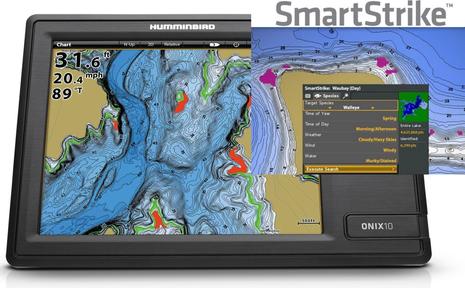 Lowrance, Garmin, Raymarine, and Humminbird are competing fiercely for the millions of smaller boat fishermen who’d like to keep their primary electronics budget under $1,000. If fishing lakes is your passion then SmartStrike on Humminbird fishfinder/plotters looks like a pretty cool feature that just might make your day more productive. Humminbird’s Helix line of plotter/fishfinder combos offer five different screen sizes from 5 to 12 inches and the 9, 10, and 12 inch models just got a free software update that includes SmartStrike (Lakemaster charts needed). The feature was only available previously on the higher priced ONIX series. By entering a target fish species along with environmental conditions and time of day and year, SmartStrike will suggest where the fish might be hanging out. At $999 or less for side/down imaging and GPS plotting capability, a 9-inch Helix (also Navionics Gold compatible) may be a fish’s worst enemy.
Lowrance, Garmin, Raymarine, and Humminbird are competing fiercely for the millions of smaller boat fishermen who’d like to keep their primary electronics budget under $1,000. If fishing lakes is your passion then SmartStrike on Humminbird fishfinder/plotters looks like a pretty cool feature that just might make your day more productive. Humminbird’s Helix line of plotter/fishfinder combos offer five different screen sizes from 5 to 12 inches and the 9, 10, and 12 inch models just got a free software update that includes SmartStrike (Lakemaster charts needed). The feature was only available previously on the higher priced ONIX series. By entering a target fish species along with environmental conditions and time of day and year, SmartStrike will suggest where the fish might be hanging out. At $999 or less for side/down imaging and GPS plotting capability, a 9-inch Helix (also Navionics Gold compatible) may be a fish’s worst enemy.
Vesper Marine software updates
In case you missed the comment in our entry on testing Vesper’s XB-8000 AIS Transponder, the no-Wifi version (XB-6000) with internal and external antennas launched last November for $200 less. Ben has long been a Vesper fan, and I purchased the Watchmate 850 transponder in 2013. Back then I noticed a bug when sending an MMSI number from an AIS target to my Icom radio. It only worked when the NMEA 0183 baud rate was set at 4800 and not 38400 (directed through my NMEA 0183 multiplexer). Within days Jeff Robbins at Vesper issued me a firmware patch which resolved the problem. That’s great customer service. That patch is still in place but I should probably update to the 850’s latest firmware which supports 5Hz GPS.
Vesper’s latest firmware for the XB-8000 includes external alarm support for man overboard and the anchor watch feature configured by the Watchmate app. The app got an update too. What’s really cool is that once set up, the anchor watch geofence data is stored in the unit and not in the app. If your phone dies you still get an alarm. Similarly the AIS SART triggered alarm requires no external equipment — described more fully in the news release. Many boaters don’t realize that AIS receivers and transponders are a piece of gear that rarely need to be matched to a specific brand of multifunction display. This gives wider feature choices like apps and the use of iThings.
New Icom 7300 HF Radio
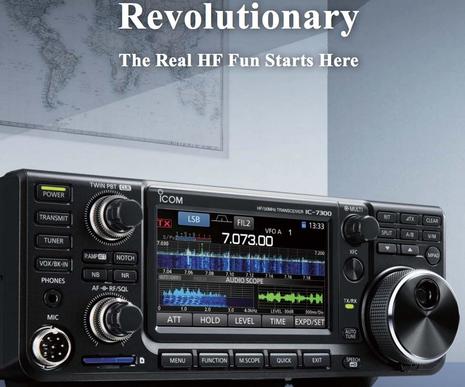 According to Icom “the real HF fun starts here.” Fun is relative of course, but if you are a ham radio geek this may be a pivotal year in the history of amateur radio. Twitter is all a buzz over Icom’s new IC-7300 HF radio transceiver. Let Icom tell it because I know I’ll mess this up:
According to Icom “the real HF fun starts here.” Fun is relative of course, but if you are a ham radio geek this may be a pivotal year in the history of amateur radio. Twitter is all a buzz over Icom’s new IC-7300 HF radio transceiver. Let Icom tell it because I know I’ll mess this up:
“Icom’s IC-7300 utilizes an RF direct sampling system which is a departure from conventional superheterodyne system. RF signals are directly converted to digital data and reduces noise generated from different IF stages. Improved RMDR and superior phase noise characteristics reduce noise components in both receive and transmit signals.”
The excitement is literally and figuratively “over my head.” What I do know is that it is all about noise — or a lack thereof — if you want to communicate with the space station or you’re bluewater cruiser using SSB (single sideband) frequencies. The 7300 can do all this at a $1500 price point which is apparently revolutionary. What I do appreciate (and is no joke) is that when disaster strikes and the landlines and cell-phones don’t work, it’s the ham radio operators that keep communications flowing. You can’t put a price on that! Our readers are perhaps better able to express what this new radio means to the history of long distance amateur radio communication?
Sorry that Panbo has been slow this week but we were not really on vacation. That’s Adam below just about to reel his biggest catch ever to the boat where the mate will release the sailfish to chase another meal. Kites and a lot of Garmin electronics were involved, and we’re both leaving Miami with lots to write about. ~ Ben


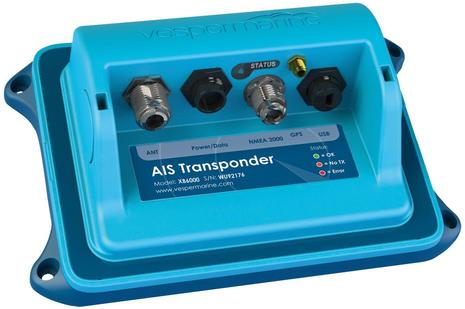
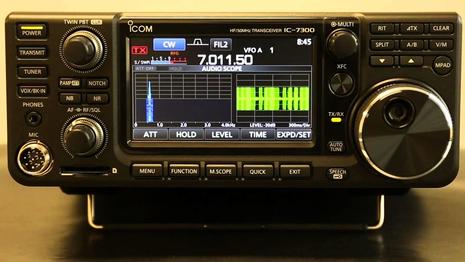
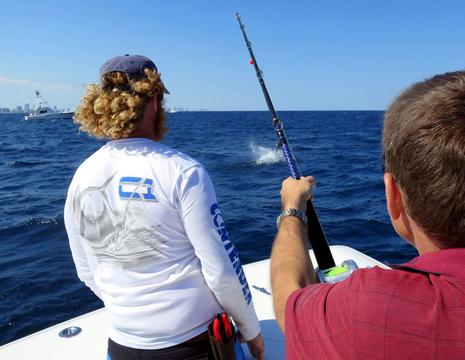
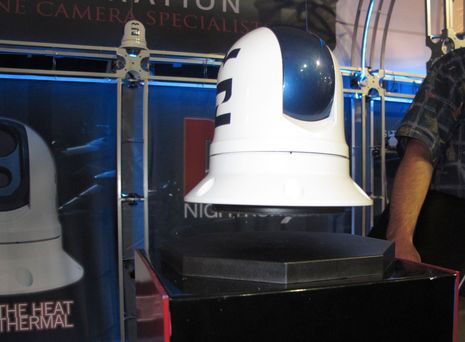
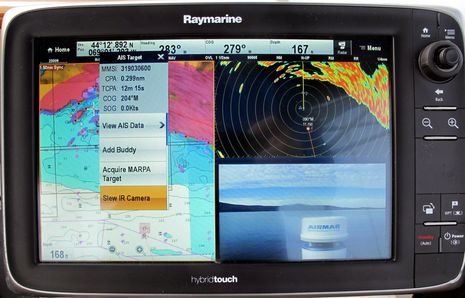

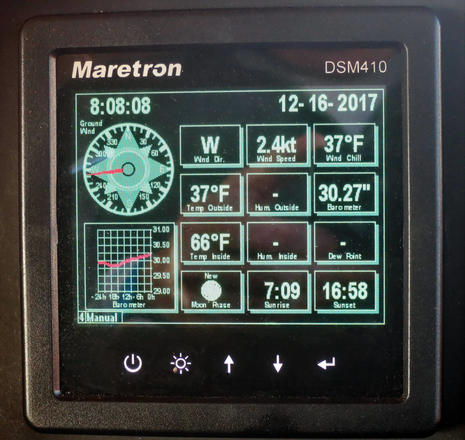






Thank you Ben for broaching the subject of amateur radio and the recreational boater. I jumped through the hoops to get a general license, which is required to operate on the amateur HF frequencies. The benefits are rudimentary email, receiving wefax, and the ability to participate on the various marine ham networks. If I only wanted HF, the marine HF radios provide all the services that the ham radios do, but Ham radio is free. Amateurs cannot use the new high speed Pactor modems, but the marine radios can. Amateur radio spectrum also covers VHF and UHF band. The ability to utilize the VHF frequencies was the tipping point for me to opt for an amateur radio over the HF marine radio.
The IC-7300 sounds like a nice amateur radio, but it isn’t for “bluewater cruiser(s) using SSB frequencies”, as it would be legal only within the amateur bands, not on the Marine channels. It also isn’t “marinized”, so it would need protection from moisture.
Yes, I know lots of cruisers save money by using amateur radios for SSB radios – but that doesn’t make it legal..:)
I know I am going to get flak for this… but…
Unless the marine SSB industry (cough, ICOM, cough) intends to give up on the cruiser market and just concentrate on the commercial/government/high end market… it needs to marinize these lower-priced radios and put a modem inside.
We have an SSB (ICOM-710), maintain it, have purchased a $1600 Pactor 4 modem for it in the last 24 months, have crossed the Atlantic…
… and if buying a new cruising boat from the factory would probably not order an SSB. The Iridium GO! has far, far outdone the ICOM for us.
I think we’d rather carry a spare sat phone if we didn’t have the ICOM already.
Cheerio,
Would assume the same technology is incorporated into the new Icom GM800 Marine SSB radio which is awaiting FCC certification.
The comments in regards to using the Icom-7300 to communicate with the International Space Station are incorrect. The Icom 7300 can only transmit and receive on HF frequencies and the 50 MHz band.
Amateur radio communications with the ISS are conducted using VHF and UHF frequencies.
Hi Y’all, I don’t think Icom intends the IC-7300 for the “cruiser market” at all – it’s not even really optimized for mobile use, let alone shipboard duty. And the cost of the Pactor modem will not go away just by putting it inside the case (though that would be nice!), as the proprietary software/firmware inside belongs to SCS, and they would charge for it, I’m sure.
That GM800 looks like a logical successor to the IC-M802, and I suspect it will be around the same price point – that is, significantly higher than the amateur HF radios in their line. Their preliminary data sheet doesn’t address what tech the receiver uses (if it’s different) and also contains a rather glaring typo in the transmitter specs.
73 DE Hartley W1OQ
Hartley, of course, the cost of the modem can’t quite go away.
All I’m saying is that if this product category is to remain viable, the industry needs to lower the entry point and make it as convenient as possible. Hence the suggestion of integration out-of-the-box.
We’ve met three cruising new-builds, all of whom have already crossed the Atlantic, one went around Cape Horn, and the other one is now in Galapagos, younger people, and they didn’t bother with SSB.
That’s what the 30 to 45 y.o. segment are doing.
Cheerio,
Has RF direct sampling system made it into our normal boat radios? If no, is it expected too shortly or is it not applicable?
Lights black? My guess is that they are low-pass filtering the pixels. That is, if the pixels are over a threshold, they block them. Not sure how the sensor works, but this may allow one to see planets next to the sun.
Just a guess!
Anon, thanks for the correction re: the International Space Station. I misinterpreted the wikipedia article I read. VHF is indeed used to contact the ISS. The following VHF frequencies are used for contacts with the ISS. The 7300 doesn’t operate at these frequencies.
Voice Downlink: 145.80 MHz (worldwide)
Voice Uplink: 144.49 MHz (regions 2 and 3), 145.20 (region 1)
Packet Uplink: 145.825 MHz simplex (worldwide)
reference:
http://www.arrl.org/frequently-asked-questions
Ben here. I want to take some responsibility for the Icom 7300 section above because I edited it without giving Adam the chance to review the edits (NOT normal procedure, just a timing thing). At any rate, it was me, not Adam, who inferred that some cruisers may like the 7300, and I stand by that (though I’ll also admit a high degree of ignorance about this tricky subject).
I definitely know blue water boaters who use ham (amateur) radios instead of marine SSB units. This deep discussion of the subject is a bit old but still relevant, I think:
http://hamradio.arc.nasa.gov/meetings/HFradioatsea.html
That reference also covers the fact that some ham radios used to need a “mod” to work with SSB frequencies, though SSB is not a set of frequencies so much as a mode, explained with some humor here:
http://www.hamuniverse.com/ssbinformation.html
Finally, here’s a more current reference to using ham at sea:
http://www.cruisingworld.com/should-you-get-your-ham-license
But, though again speaking from ignorance, I certainly get the impression many newly minted blue water types are happily using devices like the Iridium GO instead of SSB, though maybe with an HF receiver so they can at least listen to relevant cruiser nets.
Hi Ben et al,
Unfortunately, the presentation by Mr. Mogford doesn’t actually discuss the “Marine SSB vs Amateur radio” situation at all.
Suffice to say, ALL amateur radios will have to have a “mod” to work on Marine SSB channels. Some are easy to do, others more complicated. The reason they need to be modified is that they are sold as Part 97 amateur radios, and NOT as Part 87 marine radios – and the technical requirements are significantly different. Amateur radios do not need to meet any frequency accuracy standard (as long as they stay within the amateur bands), amateur radios need to suppress transmitted spurious output signals only by 50 dB, while marine (and commercial Part 90) radios must meet a stringent 43+10Log(P) suppression standard – 13 dB higher for a typical 100 watt radio. Also, the amateur radio might not even meet the amateur technical requirements if it is operated on marine frequencies (check the data sheet – you notice how the specs are guaranteed ONLY within the amateur bands?).
Does any of this make any real difference? — Maybe — while the amateur radio is clearly illegal, it can work well enough to function on marine channels, and lots of “economy minded” cruisers do exactly that (me, too, back when..:). But I wouldn’t consider an amateur radio suitable as a serious safety tool onboard for several reasons: one, no amateur radio is “marinized” with conformal board coatings, sealed relays and connectors and all the other things that go into a GMDSS-approved radio like Icom’s IC-M802; and two, they require someone with serious familiarity with all the knobs and buttons to make it work properly – while marine SSB radios are almost as simple as a VHF (albeit with more channels..:)
It’s kinda like the iPad vs dedicated chartplotter argument – an iPad (or even iPhone) CAN work just fine – but the dedicated chartplotter offers some serious advantages when the going gets rough.
–Side note — do you remember the “Bounty” replica ship that went down in “Superstorm Sandy”? Their offshore comm system was strictly HF amateur radio (using WinLink).
Dan, “straight-to-digital” receivers are around, and they do offer some advantages (particularly for multi-mode receivers) – but they are not the “game changers” that the advertising makes them out to be. For most marine radios, the difference isn’t significant.
And I can definitely understand the move of many to satellite-based offshore communications – they are easier to use, in many cases more capable, and are FAR easier to install and get working properly! Getting a good working HF-SSB setup going and using it properly requires a definite level of skill and dedication, and I wouldn’t blame anyone for avoiding it. Olde “sparks” like me and some of you guys may be all that’s left on HF one of these days..:)
I’ll just keep on pounding the old Morse key. My HF station is an Icom IC-703 with 2x 7m dipole up 7m above WL. Works FB 😉
73’s Leo PA5LS
In late October of 2014 our boat was disabled at 42N 142W by an irregular wave in a serious storm.
Here’s the thing. When you activate your beacon it’s a one-way communication signal. You have no idea what’s going to happen next. We activated ours and started pumping. Long story short, we were managing a sinking boat for nearly twelve hours before the Hyundai Grace, a container vessel bound for Panama, picked us up.
That’s a long time to wonder whether you’re going to live or die. Fortunately, we had a ham radio aboard and crew who knew how to use it. We’d been checking in daily with the Pacific Seafarer’s Net, so it was simple to coordinate information with the RCC through their operators. We learned that an aircraft had been dispatched, and then cancelled. We learned that our families were aware of our circumstances. We learned that an AMVER SAR request had been initiated.
By the time we were taken off our boat, in 50 knot winds and 8-9 meter seas–at night–we knew we had a high likelihood of survival. That was worth something to me.
Our sat phone fried when the cabin filled with salt water. You say you keep yours in a pelican case at all times? Well, go ahead and bet your life on that.
I’ve always had a sat phone, EPIRB and PLBs offshore. Now I’m adding SSB to my new boat. No amount of money or hassle is too much for the extra peace of mind you get.
FWIW . . .
We have sailed over 85,000 miles with off the shelf amateur radios aboard, since 1979. No problems with standard “non marinised” radios, such as the Atlas 215 (with crystal box for several Marine SSB frequencies) Icom 725, Kenwood TS 140S, & Icom 706. We also had a SEA 223 Marine SSB (modified by the factory for Ham use). All of these radios continued to perform well at sea, including several Atlantic and Pacific Crossings and years in the tropics. If you take care of a radio, even on a sailboat, it will take care of you! (Even radios like to stay warm and dry!)
With the ham radios we were able to save several lives both helping recovered injured sailors on remote coasts where they would have died without rescue and gave medical advice to both sailors and missionaries in areas without any medical care. We made many friends world wide. There is nothing better than having talked every day on a passage to a net operator who lives on an Island, and having him or her meet you when you took the dinghy ashore at his location.
We kept in touch with families via phone patches, and with hams ashore who relayed messages.
Perhaps the Sat phone is a better communication device, but it is lacking in that there are no nets, which may cruisers check into each day. How do you contact a boat you know is 2 or 3 days behind you to look for shipwrecked sailors? I am following a friends son who is currently crossing to the Marquesas Islands and on several ham nets each day.
The Marine SSB radio has its uses, but no longer do all ships keep watch on 2182MHz, and although there are some cruiser nets on Marine SSB–ham radio still plays a major role for the cruising sailor.
73’s KA6PKB
Big thanks to Kevin and Bob for their testimony. Amateur radios may not be at all that common on boats, but obviously they can be very important when they are.
I’ll add that the DeLorme InReach Iridium satellite messenger and tracker also has the ability to support two way text communications with rescue centers as does similar YB (Yellow Brick) and other devices.
The American Radio Relay League, (ARRL) is a ham radio organization. I have pasted a link to their news letter about an FCC action that will eventually allow us Hams to use the Pactor 4 protocol. This will allow me to jump from 300 baud to 2400 baud. There is no infrastructure now, but I am hopeful. Final FCC action is probably years away
Patrick Harman
Here is the link to the ARRL news letter.
http://www.arrl.org/arrlletter/?issue=2016-05-05
Patrick,
You can use Pactor III now, as it’s symbol rate is well below the permitted 300, with a maximum (uncompressed) effective bit rate of 2722 bps. Pactor IV is well over the 300 symbol rate, unfortunately, so it will only be authorized by the proposed change.
The change certainly makes sense to me – all the FCC wanted to do originally was to limit bandwidth, and chose what turned out to be a poor way of doing so..:(
I’m fairly sure some stations on Winlink will move up if the change happens. (Sailmail is already there, of course) Pity the P4 modems are so spendy..
“9, 10, and 12 inch models just got a free software update that includes SmartStrike (Lakemaster charts needed).”
Just to clarify – while the update was indeed free, the ordinary Lakemaster cards won’t give you SmartStrike, you’ll need the actual Smartstrike Lakemaster card to get the maps with additional functionality.
Somehow an important point has been overlooked.
It is legal to use an amateur HF radio on the high seas on those amateur frequencies the operator is licensed for (with permission of the vessel captain). There are quite a few cruisers nets that meet on amateur assigned frequencies. One can certainly listen to these with an SSB, but transmitting on these frequencies without an amateur license is strongly rejected absent an emergency.
In addition, if one travels outside of the country issuing the amateur license one needs to check whether there is a reciprocal agreement in place allowing amateur operation, if one’s license level is accepted, etc. or if one needs to apply for permission.
Essentially the equivalent rules are also in place for Marine SSB operation. One needs a license and a ship’s license as well. In the US, the FCC issues restricted licenses which amazingly require no testing, although there is also a license level equivalent to the US amateur extra level which also enables one to legally performs such things as radar maintenance and repair as well.
As an aside, I assume that the lack of operator certification for a restricted license has caused SSB radios to be sold in the US without the very useful bells and whistles modern Ham HF radios have.
Finally, given the more stringent specs for marine SSB’s, it would make sense to start with an marine SSB and modify it for amateur applications. This is easily done with the ICOM radios, although ICOM hasn’t shipped any for sale in the US since last year due to a DSC issue with FCC. Hopefully the GM800 is just around the corner, since ICOM informed me they do not intent to make the M802 again available in the US.
Don, I’m not sure who that is aimed at, but I’ll say you are absolutely correct – amateur radio is a great resource onboard.
Regarding the IC-GM800, I wonder what happened? They announced it with much fanfare in 2015, to be out in 2016 – but it seems to have disappeared from the Icom web sites other than a few traces from the original announcements. You can still buy an M802 (albeit not from a US dealer) but there just doesn’t seem to be anything new coming any more 🙁 Have ya heard anything, Ben?
Hartley,
I wrote about amateur radio simply because I felt something was missing from the discussion.
As an aside, I love the Iridium GO for downloading weather info. Its so much quicker than using a Pactor modem. I do lament that people are giving up the potential social interaction offered by SSB/Amateur radio. One of the real pitfalls of how we get info these days. I admit to tuning through all the AM bands to just hear a human voice on long solo passages….even if what I heard was unbearable drivel.
Cheers
Don
a little expensive but professional devices.
These devices are quite helpful in fishing and worth putting money in it.